
Using the Laser
The beams are level or plumb as long as the calibration has been checked (see Field Calibration
Check) and the laser beam is not flashing (see Out of Tilt Range Indicator).
OUT OF TILT RANGE INDICATOR (FIG. 3)
The DW089 laser is designed to self-level. If the laser has been tilted so much that it cannot
level itself (average >4° tilt), it will flash the laser beam. The flashing beam indicates the tilt range
has been exceeded and IS NOT LEVEL (OR PLUMB) AND SHOULD NOT BE USED FOR
DETERMINING OR MARKING LEVEL (OR PLUMB). Try repositioning the laser on a more level
surface.
SLOPING THE LASER
If the DW089 laser is tilted beyond 15° out of level, its laser beams will stay on longer between
flashes to make it easier to do angled work.
USING THE PIVOT BRACKET (FIG. 2)
WARNING: Position the laser and/or wall mount on a stable surface. Serious personal injury or
damage to the laser may result if the laser falls.
The DW089 laser has a magnetic pivot bracket (F) permanently attached to the unit. This bracket
allows the unit to be mounted to any upright surface made of steel or iron. Common examples of
suitable surfaces include steel framing studs, steel door frames and structural steel beams. The
bracket also has a keyhole slot (G) allowing the unit to be hung from a nail or screw on any kind
of surface.
USING THE LASER WITH THE WALL MOUNT (FIG. 4)
The laser wall mount (J) offers more mounting options for the DW089 laser. The wall mount has
a clamp (K) at one end which can be fixed to a wall angle for acoustic ceiling installation. At each
end of the wall mount is a screw hole (L), allowing the wall mount to be attached to any surface
with a nail or screw.
Once the wall mount is secured, its steel plate provides a surface to which the magnetic pivot
bracket (F) can be attached. The position of the laser can then be fine-tuned by sliding the
magnetic pivot bracket up or down on the wall mount.
ALIGNING THE VERTICAL BEAM – FINE ADJUST (FIG. 5)
The fine adjustment knob (H) on the top of the DW089 is for lining up the vertical beams. Place
the DW089 on a flat surface and turn the knob to the right to move the beam to the right or to the
left to move the beam to the left.
Rotating the fine adjustment knob adjusts the entire internal mechanism, maintaining the 90° angle
between the two vertical beams.
LEVELING THE LASER
As long as the DW089 laser is properly calibrated, the laser is self-leveling. Each laser is calibrated
at the factory to find level as long as it is positioned on a flat surface within average ± 4° of level.
No manual adjustments are required.
MAINTENANCE
• To maintain the accuracy of your work, check the laser often to make sure it is properly
calibrated. See Field Calibration Check.
• Calibration checks and other maintenance repairs may be performed by D
EWALT service
centers.
• When not in use, store the laser in the kit box provided. Do not store your laser at temperatures
below -5°F (-20°C) or above 140°F (60°C).
• Do not store your laser in the kit box if the laser is wet. The laser should be dried first with a
soft dry cloth.
Cleaning
Exterior plastic parts may be cleaned with a damp cloth. Although these parts are solvent resistant,
NEVER use solvents. Use a soft, dry cloth to remove moisture from the tool before storage.
Field Calibration Check
CHECKING ACCURACY – HORIZONTAL BEAM, SCAN DIRECTION (FIG. 6)
Checking the horizontal scan calibration of the laser requires two walls 30' (9m) apart. It is
important to conduct a calibration check using a distance no shorter than the distance of the
applications for which the tool will be used.
1. Attach the laser to a wall using its pivot bracket, with the laser facing straight ahead toward
the opposing wall (0 degree position).
2. Turn on the laser’s horizontal beam and mark the beam position on the opposing wall directly
across from the laser. Always mark the center of the beam’s thickness.
3. Pivot the laser to the extreme left (-90 degree position) and mark the beam position on the
opposing wall.
4. Pivot the laser to the extreme right (+90 degree position) and mark the beam position on the
opposing wall.
5. Measure the vertical distance between the lowest mark (A) and the highest mark (B). If the
measurement is greater than the values shown below, the laser must be serviced at an
authorized service center.
Distance Allowable Distance
Between Walls Between Marks
30' (9.0m) 1/8" (3.0mm)
40' (12.0m) 5/32" (4.0mm)
50' (15.0m) 7/32" (5.0mm)
CHECKING ACCURACY – HORIZONTAL BEAM, PITCH DIRECTION (FIG. 7)
Checking the horizontal pitch calibration of the laser requires a single wall at least 30' (9m) long.
It is important to conduct a calibration check using a distance no shorter than the distance of the
applications for which the tool will be used.
1. Attach the laser to one end of a wall using its pivot bracket.
2. Turn on the laser’s horizontal beam and pivot the laser toward the opposite end of the wall
and approximately parallel to the adjacent wall.
3. Mark the center of the beam at two locations (C, D) at least 30' (9m) apart.
4. Reposition the laser to the opposite end of the wall.
5. Turn on the laser’s horizontal beam and pivot the laser back toward the first end of the wall
and approximately parallel to the adjacent wall.
6. Adjust the height of the laser so that the center of the beam is aligned with the nearest
mark (D).
7. Mark the center of the beam (E) directly above or below the farthest mark (C).
8. Measure the distance between these two marks (C, E). If the measurement is greater than the
values shown below, the laser must be serviced at an authorized service center.
Distance Allowable Distance
Between Walls Between Marks
30' (9.0m) 1/4" (6.0mm)
40' (12.0m) 5/16" (8.0mm)
50' (15.0m) 13/32" (10.0mm)
CHECKING ACCURACY – VERTICAL BEAMS (FIG. 8)
Checking the vertical (plumb) calibration of the laser can be most accurately done when there
is a substantial amount of vertical height available, ideally 30' (9m), with one person on the floor
positioning the laser and another person near a ceiling to mark the position of the beam. It is
important to conduct a calibration check using a distance no shorter than the distance of the
applications for which the tool will be used.
1. Place the laser on the floor and turn on both vertical beams.
2. Mark the position where the beams cross on the floor (F) and also on the ceiling (G). Always
mark the center of the beams’ thickness.
3. Rotate the laser 180 degrees, and reposition it so the beam crossing is exactly on the original
mark (F) on the floor.
4. Mark the position where the beams cross on the ceiling (H).
5. Measure the distance between the two ceiling marks (G, H). If the measurement is greater
than the values shown below, the laser must be serviced at an authorized service center.
Ceiling Allowable Distance
Height Between Marks
8' (2.5m) 1/16" (1.5mm)
10' (3.0m) 3/32" (2.0mm)
14' (4.0m) 1/8" (2.5mm)
20' (6.0m) 5/32" (4.0mm)
30' (9.0m) 1/4" (6.0mm)
CHECKING 90º ACCURACY BETWEEN VERTICAL BEAMS (FIG. 9)
Checking 90º accuracy requires an open floor area at least 33' x 18' (10m x 5m). Refer to Figure
9 for the position of the DW089 at each step and for the location of the marks made at each step.
Always mark the center of the beams’ thickness.
1. Set up the laser in one corner of the floor and turn on the forward vertical beam.
2. Mark the center of the beam at three locations (A, B and C) on the floor along the laser line.
Mark B should be at the midpoint of the laser line.
3. Move the laser to mark B and turn on both vertical beams.
FIG. 6
b
Step 1 / Étape 1 / Paso 1
a
Step 3
Étape 3
Paso 3
-90˚
90˚
Step 4
Étape 4
Paso 4
Step 5 / Étape 5 / Paso 5
Step 2
Étape 2
Paso 2
Step 3
Étape 3
Paso 3
FIG. 7
c
d
d
c
e
30' (9m)
Step 1, 2
Étape 1, 2
Paso 1, 2
Step 3 / Étape 3 / Paso 3
Steps 4, 5
Étapes 4, 5
Pasos 4, 5
Step 6 / Étape 6 / Paso 6Step 7 / Étape 7 / Paso 7
Step 8
Étape 8
Paso 8
Step 3 / Étape 3 / Paso 3
FIG. 3
>4°
AVERAGE
EN MOYENNE
PROMEDIO
H
FIG. 5
(+)
(+)
A
(–)
(–)
FIG. 2
A
I
F
K
J
L
FIG. 4
FIG. 8
Step 3
Étape 3
Paso 3
Step 1
Étape 1
Paso 1
Step 2
Étape 2
Paso 2
Step 2
Étape 2
Paso 2
Step 4 / Étape 4 / Paso 4
f
g
h
g
f
Step 5 / Étape 5 / Paso 5
B
D
C
E
H
F
A, I
G

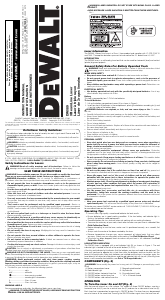


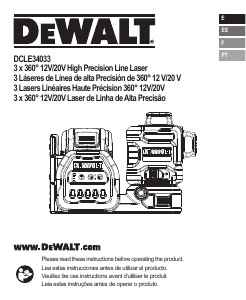
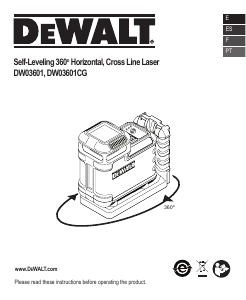
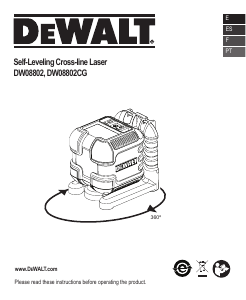
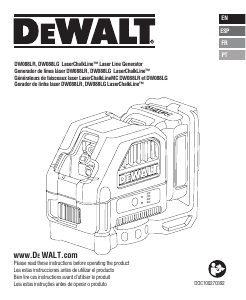
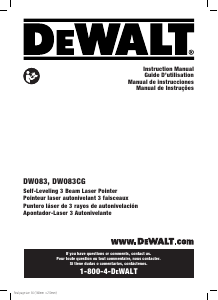
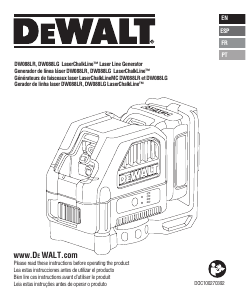
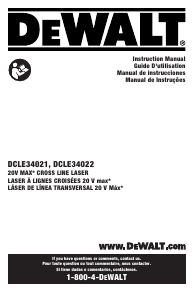

Praat mee over dit product
Laat hier weten wat jij vindt van de DeWalt DW089K Lijnlaser. Als je een vraag hebt, lees dan eerst zorgvuldig de handleiding door. Een handleiding aanvragen kan via ons contactformulier.